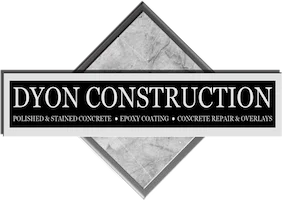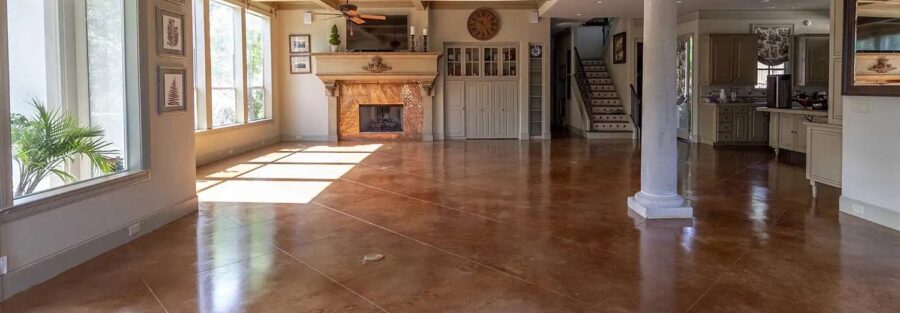Concrete staining offers an exceptional means of elevating the aesthetic appeal of concrete floors. This technique transforms plain, utilitarian surfaces into visually stunning features that enhance both residential and commercial spaces. Affordable and highly customizable, concrete staining provides a spectrum of color options and patterns to suit any design vision. Whether you’re looking to revamp your basement, patio, or retail space, stained concrete can deliver a sophisticated, high-end look without the exorbitant costs of traditional flooring materials.
Benefits of Concrete Staining
Concrete staining is renowned for its aesthetic versatility. The array of colors available ranges from rich, earthy tones to vibrant hues, allowing for personalized and striking results. Staining can mimic the appearance of natural stone, leather, or even marble, providing a luxurious finish at a fraction of the cost. Furthermore, the ability to incorporate intricate patterns and designs means that no two stained floors need be alike, making each project uniquely tailored to its environment.
Another significant advantage is the long-lasting nature of stained concrete. Unlike some flooring options that may fade or wear over time, stained concrete is resilient to the rigors of daily use. The stain penetrates deeply into the surface, creating a durable, enduring finish that resists chipping and peeling. This inherent strength makes stained concrete an excellent choice
Types of Concrete Stains
When selecting a concrete stain, it’s essential to understand the different types available. Acid-based stains and water-based stains are the two primary categories, each offering unique characteristics and finishes.
Acid-based stains work through a chemical reaction with the minerals in the concrete, producing rich, variegated tones that often resemble natural stone. These stains create a translucent effect, adding depth and dimension to the surface. The reaction results in a more permanent color change, which can be highly desirable for achieving a natural, antique look.
In contrast, water-based stains use pigments suspended in a water solution. These stains offer a broader range of colors and provide a more consistent and opaque finish compared to acid-based options. They are also easier to apply and clean up, making them a popular choice for DIY enthusiasts. Water-based stains are less likely to react with the concrete’s minerals, allowing for more control over the final color and appearance.
Preparation and Application Process
Proper preparation and application are crucial for achieving a flawless stained concrete surface. Begin by thoroughly cleaning the concrete. Remove all dirt, oil, and grime using a degreaser or heavy-duty cleaner. Any existing coatings or sealers should be stripped away to ensure that the stain can penetrate effectively. A thorough rinse and complete drying of the surface are essential before proceeding.
Once the concrete is prepped, apply a concrete etcher if needed, to open up the surface and enhance stain absorption. Follow the manufacturer’s instructions for mixing and applying the stain. Typically, the stain is applied using a sprayer, roller, or brush, depending on the desired finish. For an even application, work in manageable sections and ensure that the stain is spread uniformly to avoid streaks or blotches.
Allow the stain to dry thoroughly before applying a sealer. The sealer will protect the stained surface from moisture and wear while enhancing the depth and vibrancy of the color. Follow the sealer’s application instructions closely to achieve a smooth, glossy finish.
Tips for Achieving the Best Results
To ensure the best possible outcome, adhere to these best practices:
- Avoid Streaks and Uneven Coloring: Work in consistent lighting to monitor the stain application and ensure even coverage. Apply the stain in one direction to avoid overlap marks or streaks.
- Test First: Always test the stain on a small, inconspicuous area of the concrete to preview the color and effect. This helps to adjust application techniques and color expectations.
- Use Quality Tools: Invest in high-quality applicators and tools to achieve a smooth, professional finish. Cheap brushes or rollers can lead to uneven results and affect the overall appearance.
- Follow Drying Times: Ensure each layer of stain and sealer is fully dry before applying additional coats or walking on the surface. Rushing this process can lead to poor adhesion and finish quality.
Maintenance and Longevity
Maintaining stained concrete floors is straightforward and ensures their longevity. Regular sweeping or vacuuming removes dirt and debris that can cause surface abrasion. For routine cleaning, use a mild, pH-balanced cleaner and a damp mop. Avoid acidic or abrasive cleaning agents, as these can damage the stain or sealer.
Sealing is vital to protect the stained surface from moisture, stains, and wear. Reapply the sealer periodically, as recommended by the manufacturer, to maintain the floor’s shine and durability. Regular resealing helps to preserve the color and prevent any deterioration of the surface.
Staining concrete floors offers a compelling blend of aesthetic appeal and durability, making it a superior choice for many applications. With its wide range of colors and patterns, affordability, and long-lasting performance, stained concrete can elevate any space while remaining cost-effective. Whether you’re a DIY enthusiast or considering professional help, this guide provides the necessary steps and tips to achieve stunning results. Embrace the transformative power of concrete staining and enjoy a stylish, resilient flooring solution for years to come.

